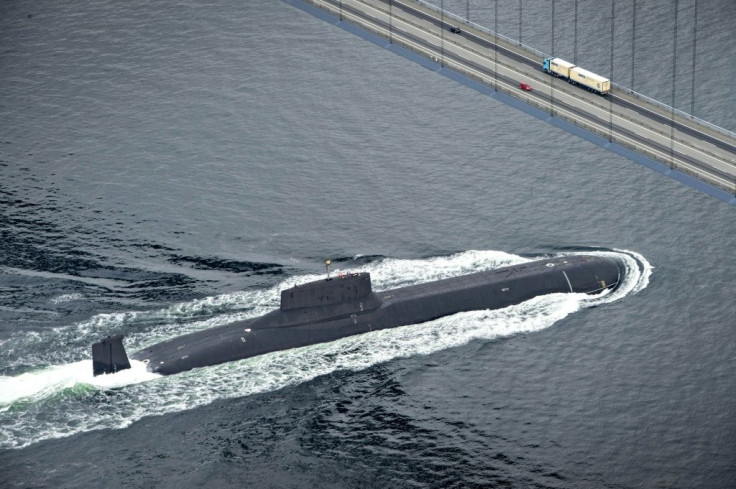Russia May Test Nuclear-Tipped Underwater Super Drones With World's Biggest Nuclear Sub, NATO Warns
KEY POINTS
- NATO has warned that Russia's nuclear submarine K-329 Belgorod left its base in the Arctic Circle, according to reports
- K-329 Belgorod is capable of carrying the Poseidon nuclear-armed underwater drones.
- The Poseidon is a huge robotic nuclear-capable mini-submarine drone capable of triggering radioactive tsunamis
With the annexation of Ukrainian territories following the sham referendum and his veiled nuclear threat at a time when Moscow faces major reversals on the battlefronts, Russian President Vladimir Putin may now be setting the stage to push Russia's war in Ukraine toward an unprecedented nuclear confrontation, NATO has reportedly warned.
Media reports based on NATO intelligence claimed that Russia's K-329 Belgorod, the world's biggest nuclear-powered submarine that is capable of carrying nuclear-tipped underwater super drones, has left its base in the Arctic Circle in preparation for a series of secret tests. Other reports said a train with military hardware belonging to Russia's specialist division responsible for handling nuclear weapons has been spotted moving toward the frontline in Ukraine.
Following his decree on partial mobilization, Putin ramped up his nuclear threat, warning that he was not bluffing when he said Russia would use all means to defend its territory, which now includes the four Ukrainian regions illegally annexed by Moscow. Since then, fears have escalated that Russia may push its war in Ukraine to an unpredictable new stage of nuclear readiness and confrontation.
Russia's nuclear submarine K-329 Belgorod left its base in the Arctic Circle, according to NATO intelligence. However, the submarine remains in the Arctic waters and may be on its way to the Kara Sea, off the coast of Russia's Novaya Zemlya island, to conduct a series of secret tests, media reports quoting the Italian newspaper La Repubblica claimed.
The exact specifications of the Russian submarine K-329 Belgorod are not known. However, the Belgorod is estimated to be 178 meters long and 15 meters across, which makes the Typhoon-class submarine the only larger vessel, as per defense analyst H I Sutton's Naval News report. The Belgorod has a displacement of over 19,000 tons and is bigger than the largest Western submarine, the US Ohio-class. The Russian Navy took delivery of the K-329 Belgorod in July.
The NATO warning regarding the movement of the submarine is significant because the K-329 Belgorod is the first carrier of the Poseidon nuclear-armed underwater drone. It is feared that Putin may use the Ukraine war to test the Poseidon.
In February 2019, the Russian Defense Ministry released the first-ever video showing an underwater "field test" of the Poseidon, a huge robotic nuclear-capable mini-submarine with an inbuilt miniature nuclear reactor.
Video of Russian Poseidon underwater nuke drone ‘field-test’ released by Defense Ministry
— RT (@RT_com) February 21, 2019
Details: https://t.co/ZDIImXymQb pic.twitter.com/ujoUC4pBdG
The said weapon "uses its on-board mini nuclear reactor to slowly approach enemy territory at low speed deep underwater. If sensing detection, it can greatly boost its speed at the expense of noise and simply outrun its pursuer before going back into stealth mode," according to a Russia Today report.
Once at its target, it can detonate the nuclear payload with a devastating explosion that could trigger radioactive tsunamis capable of wiping out enemy coastlines. With the "field test" phase complete, the Poseidon weapon system is ready and is meant to be carried by a regular manned submarine like the K-329 Belgorod and deployed when necessary. The NATO warning now indicates that Russia may be preparing to carry out the tests.
A clip posted by pro-Russian channel Rybar on Telegram Sunday showed the movement of BPM-97 armored personnel carriers (APCs) and other military vehicles through central Russia, according to a report.
The report said such advanced military hardware, which belongs to Russia's 12th Main Directorate, has rarely been deployed on the frontline in Ukraine. The 12th Main Directorate is a specialist division dedicated to the storage, maintenance and provision of weapons like the Strategic Rocket Forces, a key part of Putin's nuclear program.
Meanwhile, U.S. Secretary of State Antony Blinken said on Sept. 30 that despite the "loose talk" by Putin about their possible use of nuclear weapons, there has been no indication to suggest that Moscow is contemplating its use.

© Copyright IBTimes 2024. All rights reserved.






















